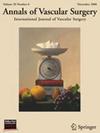机器人辅助腹腔镜手术治疗正中弓状韧带综合征的8年经验。
IF 1.4
4区 医学
Q3 PERIPHERAL VASCULAR DISEASE
引用次数: 0
摘要
背景:由于中弓韧带综合征(MALS)的罕见性,对中弓韧带松解术(MALR)的手术入路研究不足。本系列旨在回顾机器人辅助腹腔镜MALR从四级护理中心。方法:这是一项单中心队列研究,研究对象是2015年3月至2023年6月期间接受机器人辅助腹腔镜MALR的成年患者。临床病理资料从患者的电子病历中提取,随访至少30天。我们的主要结果是症状改善,这是通过回顾术后患者就诊的医疗记录来评估的。采用Fisher精确检验进行双变量分析。结果:确定了20例患者。患者手术时平均年龄为41.65(±16.02)岁,其中16例(80%)为女性。许多患者同时被诊断为胃肠道疾病,包括克罗恩病/肠易激综合征(40%)和胃反流(35%)。13例(65%)患者被诊断患有DSM-5精神疾病。最常见的术前慢性症状包括餐后疼痛(90%)、慢性腹痛(85%)和意外体重减轻(85%)。术后,10例患者的意外体重减轻完全缓解(p=0.0031),慢性肌萎缩侧翼肌萎缩症症状显著改善,包括腹痛、餐后疼痛、恶心和意外体重减轻。中位随访时间为1.63(0.97 - 2.69)年。手术特征包括平均手术时间为133.25±25.91分钟,中位估计失血量为20 (8.75 - 25.00)mL, R-MALR前后腹腔动脉吸气或呼气峰值收缩速度无显著变化。患者的中位住院时间为2(1-3)天。20例患者中有2例(10%)因胃食管交界处损伤和胃左动脉假性动脉瘤返回手术室。术后30天无死亡病例。结论:我们单一机构的经验证明,机器人辅助腹腔镜下正中弓状韧带松解术是一种安全有效的中期缓解肌萎缩侧索硬化症症状的选择。本文章由计算机程序翻译,如有差异,请以英文原文为准。
An 8-Year Experience of Robot-Assisted Laparoscopic Surgical Management of Median Arcuate Ligament Syndrome
Background
Due to the rarity of median arcuate ligament syndrome (MALS), surgical approaches to median arcuate ligament release (MALR) have been understudied. This series aimed to review robot-assisted laparoscopic MALR from a quaternary care center.
Methods
This is a single-center cohort study of adult patients who underwent robot-assisted laparoscopic MALR between March 2015 and June 2023. Clinicopathologic data were abstracted from the electronic medical record for patients with at least 30 days of follow-up. Our primary outcome was symptom improvement, which was assessed via review of the medical record from postoperative patient visits with a provider. Bivariate analyses were performed using Fisher's exact test.
Results
Twenty patients were identified. The mean age of patients at the time of surgery was 41.65 (±16.02), and 16 (80%) of the patients were female. Many patients had concomitant diagnoses of gastrointestinal illnesses, including Crohn's or irritable bowel syndrome (IBS) (40%) and gastroesophageal reflux disease (GERD) (35%). Diagnostic and Statistical Manual of Mental Disorders-5 (DSM-5) psychiatric illnesses were diagnosed in 13 (65%) patients. The most frequently encountered preoperative chronic symptoms included postprandial pain (90%), chronic abdominal pain (85%), and unintended weight loss (85%). Postoperatively, 10 patients experienced complete resolution of unintended weight loss (P = 0.0031) and significant improvement in chronic MALS symptoms, including abdominal pain, postprandial pain, nausea, and unintended weight loss. The median follow-up time was 1.63 (0.97–2.69) years. Operative characteristics include the mean operative time of 133.25 ± 25.91 minutes, median estimated blood loss of 20 (8.75–25.00) mL, and no significant changes in inspiratory or expiratory celiac artery peak systolic velocity between measurements before and after robot-assisted laparoscopic median arcuate ligament release (R-MALR). Patients had a median length of stay of 2 (1–3) days. 2 of 20 patients (10%) experienced a return to the operating room for an injury to the gastroesophageal junction and pseudoaneurysm of the left gastric artery. There were no mortalities within 30 days of operation.
Conclusion
Our single-institution experience offers evidence that R-MALR release can be a safe and effective option for medium-term relief of MALS symptoms.
求助全文
通过发布文献求助,成功后即可免费获取论文全文。
去求助
来源期刊
CiteScore
3.00
自引率
13.30%
发文量
603
审稿时长
50 days
期刊介绍:
Annals of Vascular Surgery, published eight times a year, invites original manuscripts reporting clinical and experimental work in vascular surgery for peer review. Articles may be submitted for the following sections of the journal:
Clinical Research (reports of clinical series, new drug or medical device trials)
Basic Science Research (new investigations, experimental work)
Case Reports (reports on a limited series of patients)
General Reviews (scholarly review of the existing literature on a relevant topic)
Developments in Endovascular and Endoscopic Surgery
Selected Techniques (technical maneuvers)
Historical Notes (interesting vignettes from the early days of vascular surgery)
Editorials/Correspondence

 求助内容:
求助内容: 应助结果提醒方式:
应助结果提醒方式:


